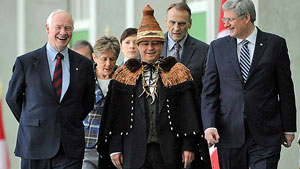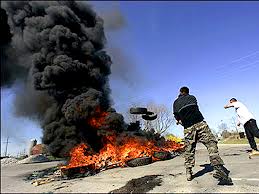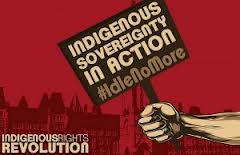War of the Words: Chiefs Issue Ultimatums as Grassroots Dance in Circles
by Zig Zag
January 4, 2013
 Flash mob in Edmonton mall, December 2012.
Flash mob in Edmonton mall, December 2012.
Despite their working relationship with many Indian Act chiefs, the founders of Idle No More (INM) publicly distanced themselves in a statement issued on Dec 31, 2012. This was in response to chief Theresa Spence’s demand that other Indian Act chiefs “take control” of the grassroots mobilizing that has occurred.
“The Founders and many of the organizers of Idle No More from Across Canada have been given word that the Leadership is calling for action in the name of Idle No More. They have also stated in a press release that they have met with Idle No More representatives that support this call. We would like to state that this is FALSE.
“The Chiefs have called for action and anyone who chooses can join with them, however this is not part of the Idle No More movement as the vision of this grassroots movement does not coincide with the visions of the Leadership. While we appreciate the individual support we have received from Chiefs and councelors [sic], we have been given a clear mandate by the grassroots to work outside of the systems of government and that is what we will continue to do. We are not trying to have division amongst this movement! However Chief Nepinak stated, “we are behind the grassroots people”. Please let others know!!!!
“There have been talks of getting leaders to lead, however, we are the leaders!!! Remember that!!!!”
(“Face and Leaders of Idle No More is the Grassroots People,” Idle No More website, Dec 31, 2012)
Considering the historical role of band councils to control Native peoples, this is the only position the “official” INM could take without appearing as pawns of the chiefs. Nevertheless, most of the INM rallies have seen chiefs and councilors centre stage, delivering the speeches, and providing logistical support (a fact that INM recognizes in their statements).

From the time that the chiefs carried out their symbolic attempt to enter the House of Commons on Dec 4, when Bill C-45 was being debated, INM has had to carefully tread its way through the potentially divisive issue of just how grassroots the mobilization has been. It appears to have been a symbiotic relationship: INM would not have gained the prominence it did on Dec 10 without the chief’s Dec 4 action & subsequent organizing. On the other hand, the chiefs by themselves could never have succeeded in mobilizing so many thousands of Natives into the streets (and shopping malls) on their own.
For these reasons, it was a foolish move on Spence’s part to focus attention on the chiefs and the prospect of them taking direct control over INM activities. Many grassroots people reacted with disdain at this proposal, hence the INM’s efforts to distance themselves from the chiefs. Despite this, there are still many who continue to claim that unity is more important right now, while some have begun to champion the chiefs as genuine leaders.

Even chief Spence, however, had to backtrack on her initial “call to arms” and admit that the chiefs had made “mistakes” in the past but that INM shouldn’t “shame” them by not following their orders. In another statement read out by one of her assistants, Spence stated:
“Let us come together in unity, because all of us, chiefs and grassroots, are one. If we are going to point fingers, let us point them squarely at this colonial government. The chiefs have made mistakes in the past, but don’t shame them for these. They are, after all, our people. The chiefs are ready now to humble themselves for the people.”
(“Attawapiskat Chief Spence urges Idle No More to unite with leadership,” APTN National News, Jan 2, 2013)
Band Councils Are Not Grassroots
It should come as no surprise that chief Spence wants us to “forgive and forget” the shameful practises of many Indian Act chiefs and councillors, being one herself. But is it true that the chiefs and grassroots “are one” and that therefore we must come together?
Band councils were imposed under the Indian Act not to unite our people, or to lead them in resistance, but to control them, to administer government policies, and to suppress any genuine grassroots resistance from emerging. This in itself was an act of division which created a special managerial class of Natives and led to the growth of an Aboriginal business elite whose interests are not in accord with those of real grassroots people.

In an effort to retain his legitimacy as a genuine “leader” and to promote “unity,” grand chief Derek Nepinak of the Assembly of Manitoba Chiefs (AMC, the AFN provincial arm in Manitoba) penned his own letter, stating:
“There is no need to fight for control over the energy that has spread like wildfire across the turtle’s back. It is incorrect for me or any other Chief to try to co-opt or control Idle No More as it would only frustrate the beautiful expressions of the energy of the spirit that is now empowering our people. It is equally incorrect for organizers of Idle No More to try to limit the participation of any of our people, Chiefs or otherwise.”
(“A note to Idle No More: Inclusion and respect will make the fire stronger,” by Derek Nepinak, Rabble.ca, Jan 1, 2013)
Nepinak, clearly more astute than Spence, denies any effort on the part of the chiefs to co-opt or control the grassroots, saying it would be incorrect to do so. At the same time, he counters that it would be incorrect for INM to try and limit the participation of the chiefs. Clearly, INM has never made any effort to limit the involvement of the chiefs, and in fact have welcomed it from the beginning.

Some Natives have been throwing around the term “unity” in an effort to stifle any debate or discussion about the role of the chiefs in INM. When chief Spence states that we should focus our sights on the colonial government, she’s correct. But she, and others attempting to squash any debate about the issue, are neglecting the fact that the band councils are themselves an integral part of the colonial system. They are in fact an arm of the state, which is why they were created and why they continue to be maintained, despite any radical rhetoric or posturing on the part of some chiefs, or internal power struggles they may have with their benefactors.
Nepinak’s AMC, it should be recalled, saw its own government funding slashed from some $2.6 million a year to just $500,000 , effectively crippling his corporation’s activities (cuts to mostly provincial and treaty organizations were announced on Sept 4, 2012).
According to a Dec 7 Canadian Press report, when Nepinak and other chiefs were helping to orchestrate the INM rallies of Dec 10, Nepinak stated that,
“they hope to send a message to members of OPEC, to China and others in the international community that they “did not cede, release or surrender our natural resources to a colonial government.”
“He says aboriginals are “waking up from a 100-year slumber” and will impose their own laws.

This week, Nepinak and Ontario Nishnawbe Aski Grand Chief Stanley Beardy met with a senior official from the Canadian Chinese Consulate to discuss business possibilities with China.”
(“Manitoba chiefs support national land rights movement, plan rally,” by Canadian Press, Dec 7, 2012)
So while many Natives naively believed that the chiefs were backing their protests to protect Mother Earth, the chiefs were actually busy trying to establish their own business deals with corporations whose main interests are resource exploitation (including mining, oil, & gas).
If so many Natives are angered by Bill C-45, what will they do when they learn about all the self-government agreements currently being negotiated, including those under the BC treaty process?
Under these agreements, band councils gain greater municipal powers, reserve lands become fee simple property (which can be bought and sold, not only leased), the Indian Act ceases to apply, taxation is imposed (and collected by the new Native government), etc. These measures lead to greater legal, political, and economic assimilation of Indigenous peoples. In short, the very termination policy currently being protested as being part of Bill C-45 is one that many chiefs are actively participating in.

Some Natives acknowledge the overall corruption and oppression inherent in the band council system, but assert that they are family and community members, first and foremost. But if you have a group of liberation fighters that includes, say, your brother who is a police informant, do you then ignore this unpleasant reality and act as if he’s not collaborating with the enemy simply because he’s your brother? Of course not. Every anti-colonial liberation movement must contend with the collaborators in its ranks, and Indigenous resistance in North America is no exception (a fact that dates back to the initial period of European colonization, which even then relied on Native collaborators).
Chiefs Make Their Move
Undeterred by INM’s effort to put distance between itself and the chiefs, or scepticism about their role among grassroots Natives, the chiefs unveiled their own bold plans for further co-opting the movement. This includes a renewed campaign of civil disobedience to be launched on January 16 with “country-wide economic disruptions” threatened (see “First Nations chiefs contemplate “breach of treaty” declarations, indefinite economic disruptions,” b>y Jorge Barrera, APTN National News, Jan 1, 2012).
Shawn Atleo, head of the Assembly of First Nations (AFN), followed up this threat with an invitation to the prime minister to once again meet with the Indian Act chiefs, this time on January 24, 2013. For some, there may be a sense of deja vu at this turn of events.
Last January, the Crown-First Nations Summit occurred as a result of the media coverage about housing conditions on the Attawapiskat reserve, where Spence is the band council chief. The summit itself was little more than a photo-op for the chiefs and prime minister.

Now, a year later, and after thousands of Natives have rallied and “flash-mobbed” for a month, the chiefs are attempting to set up another meeting that will most likely have the same results as the one held last year.
Chief Spence, however, almost immediately countered with a demand that a preliminary meeting between First Nations “leaders” and the PM must occur within 72 hours, not three weeks as suggested by the AFN (see “Spence wants action from Ottawa within 72 hours,” The Canadian Press, Jan. 3, 2013).
Through her aides, Spence also communicated that if her ultimatum wasn’t met, “mass demonstrations” would occur.
Spence’s reason? Her health and energy are declining as a result of her hunger strike, which has now been ongoing for 24 days. According to statements from her aides, she can’t wait until January 24, although she doesn’t oppose another Crown-First Nations summit occurring at that time.

This, of course, is another in a series of poorly planned moves on Spence’s part, indicating a weakening of her resolve that the state will undoubtedly make note of. If she can’t wait until January 24, they certainly can. Subsisting on medicinal teas and fish broth, Spence will be further weakened by that point but would unlikely die (unless there are other health problems compounded by the hunger strike).
The ending of Spence’s hunger strike, either by herself or as the result of the meeting she demands, would certainly dampen INM mobilizing, much of which has been focused on backing her action (so much so that some media accounts mistakenly label her the “leader” of INM). There is no doubt the hunger strike has heightened people’s emotional investment in the situation, while investing it with liberal amounts of spiritual mysticism.
Any repeat of the Crown-FN summit, in fact, could itself undermine much of the grassroots mobilizing that has occurred under the INM banner. This is because many Natives who’ve jumped on the INM band wagon are actually following the chief’s lead under the illusion that it is an entirely grassroots movement which the chiefs are simply supporting. Their apparent ability to gain concessions from the state will serve to reaffirm their position as genuine “leaders.”

Nevertheless, the greatest contribution of Idle No More may have already been achieved: the mobilization of thousands of Natives. As time passes, more will learn and become aware of the duplicitous and opportunistic methods of most Indian Act chiefs. Even now grassroots people are discussing and debating what a grassroots movement looks like, what its methods and goals should be, etc. So, even if the chiefs temporarily triumph and serve their role as managers of anti-colonial revolt, the people are now more aware and aroused. In a time of declining socio-economic conditions and increasing austerity measures, the potential for greater Indigenous resistance is now greater than it has been in many years.


One Comment